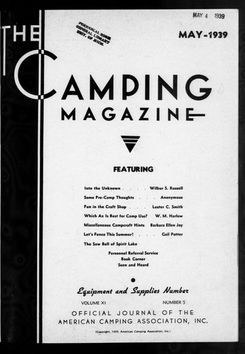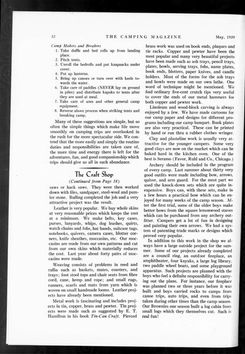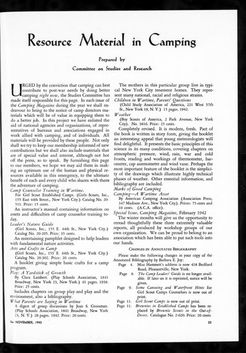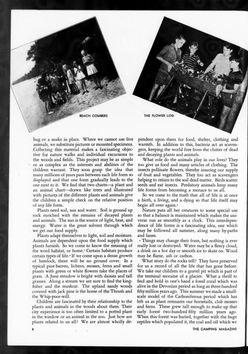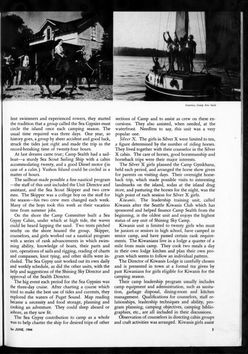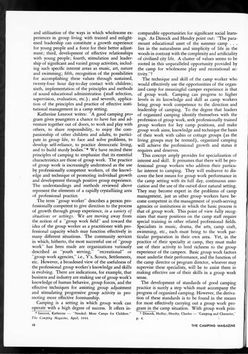Arts and Crafts with Inexpensive Materials
Girl Scouts of American, 1941
In the instructional resource booklet Arts and Crafts with Inexpensive Materials (1941), the Girl Scouts of America declared,
"If we feel that the arts and crafts are worth doing, they are worth doing well, with sound ideals and objectives.”
Following this introductory section, the book includes sections for each main area of arts and crafts activities, including but not limited to Color, Clay and Plaster, Leather, Marionettes, Metal, Prints, Natural Materials, Wood, and Textiles. Within these larger sections of materials are the types of activities and instructions. These include tie-dyeing, tin-can lanterns, leather crafts, weaving, linoleum prints, and camp gadgets.
Flip through selected pages of this guide below to learn more →
Beginning in 1930, Camping Magazine served as a platform for talking about all sorts of issues related to youth summer camps. Below are examples of articles discussing arts and crafts in summer camps from 1939-1945. You can also view the entire archived collection on The Internet Archive.
Click on each cover to expand and read the selected articles.
Fun in the Craft Shop,
Camping Magazine
May 1939
“Strange as it may seem, fun in crafts, is the controlling motive in our craft program. True, we do such other things as teaching tool skill, motor coordination, appreciation of good workmanship, principles of design, beauty of a well-finished project and many other accepted aims in the field of industrial education. However these are pushed to the background of the minds of the instruction and our main objective, fun, is, right out in the open”.
What the Average Camp Spends
Camping Magazine
April 1940

The Creative Approach to Crafts in Camp
Camping Magazine
November 1940
“There has been much loose use of the term “creative” in relation to arts and crafts. First, there prevailed the idea that the term creative indicated and directed experimental experience, which presented the same phenomenon as did the man who jumped on Horseback and wrote an all directions. Such so-called creative efforts resulted, except in the very young, and a general sense of failure and futility…The second popular conception of the term “creative” applies to those arts not immediately useful….”
“Return for a moment, however, to the thought of national influence on arts and crafts, we all, no doubt, remember when the term “Creative Design” seemed to cover mostly flowers and fruits, swirls and scrolls, which were the direct result of our contact with the Russian ballet and Frank Chizek’s [Franz Cizek] exhibitions of his students’ work. Often to the layman, a bird rendered and in free flowing, and we will admit, a charming line, is thought to be creative, simply because it is not a literal photographic rendering of a bird. Actually, it may be a bird that, to a Slovak, represents a creative National expression, but when copied by an American child, it is not remotely connected with a personal experience and expression which is connotated by the term “creative.” Some lengths has been devoted to this discussion because to initiate a creative craft program in a camp demands a clear understanding of the terms used”.
Applying Democratic Principles to the Arts and Crafts
Camping Magazine
May 1941
“An our educational pattern, camps play an important role. Because of this, it is to be hoped that camp directors do not climb on the bandwagon of defense this summer, but rather they get serious reconsideration to those factors in which camp are unique and use them in strengthening the democratic fabric of our nation. The very basic basis of democracy is a youth trained in the democratic exchange of ideas, equipped with a wealth of informative data, trained in critical analysis, imbued with the conviction that means Integrity is the basis for civilization, and fearless to defend these convictions against charlatans of no matter what portions! Such a youth is possible if our education is democratic, and camps can make a definite contribution to democratic education.”
“Arts and crafts should be a means by which campers can interpret their new experiences, and by which they can give expression to new thoughts, feelings, and reactions stimulated by these experiences. to accomplish such ends, studios that are adequately but simply equipped are needed."
“Because of this limited concept, commercially sponsored kits and trinkets are seized upon and are used to impress uncritical persons, to serve as a false front, to fill in time, and to take the place of wise, mature leadership. There's a lot of loose thinking about the arts. There are still messages of the threadbare concept of art as being something just a little above the reach of the ordinary person— something that can be appreciated only if your hair is long or your pocketbook bulging. We still hear try rumors of " art for art's sake.” Such concepts of the arts cannot produce a sound starting point for the production of good or creative art”.
“In terms of national defense, arts and crafts are a vital factor, provided they are administered creatively. Thus administered, they will give youth an opportunity to test his wings, his ingenuity, his ability to say the thing he wants to say in form, line, and color, to make beautiful the functional articles for which he has a need. The opportunity to test thought and feeling and uses is a vital need in preparing for true democracy. Democracy needs creative citizens, who honestly test their own thoughts and emotions, and who have the courage to defend recognized values. These attitudes and abilities are all learned, and they can best be learned through a creative approach to new problems and experiences. In this process, a creative arts and crafts program is of vital importance."
March 1939
Setting the Stage for Camping Safety
Without Benefit of Dollars: A Camp Handicraft Program
In the Bountiful Forest Are Many Native Stains and Dyes
Personal Referral Service (Arts and Crafts Counselor Feature)
May 1939
Fun in the Craft Shop
Book Corner: Arts and Crafts
February 1940
American Camping Association Incorporated: Structure and Committees
April 1940
Pottery Making as a Camp Activity
What the Average Camp Spends
November 1940
The Creative Approach to Crafts in Camp
A College Creates a Camp for its Counselors in Training
February 1941
18th Annual Convention
Camp Ceramics Take the Nature Trail
Self-Hardening Clays
May 1941
Applying Democratic Principles to the Arts and Crafts
November 1943
Camping~~What Contributions Now?
How Can We Secure and Develop Leadership
Resource Material in Camping: Arts and Crafts
January 1944
Program Aims for Camping, 1944?
An Approach to Nature Lore in Camp
A Counselor Placement Service for the Chicago Section
Resource Material in Camping: Arts and Crafts
April 1944
Needed: More Camps for Children
Counselor Training Courses Offered
June 1944
Interest Units for Senior Campers
Food Fights for Freedom~~On the Camp Front, Too,
Dig a Well
Camp Festivals
Camping for Crippled Children
Resource Materials in Camping
March 1945
Group Work and Camping
March 1939
May 1939
February 1940
April 1940
November 1940
February 1941
May 1941
November 1943
January 1944
April 1944
June 1944
March 1945



























